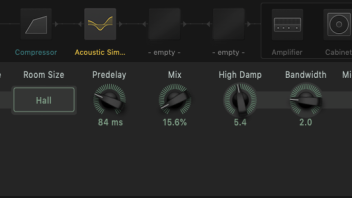Now that sounds better than I have imagined.
Can you tell us about the signal flow in the Profiler and the pickup and Acoustic Simulator settings?
Have you used additional equalizers?
Thanks for mentioning at Youtube the dilemma of using additional profiles.
High praise indeed - thank you sir! I used the bridge pickup on all three and rolled the high end off a little with the tone pots. Kemper signal chain was simply: Guitar > Kemper > AS > PureBoost > Legacy Reverb > Output EQ
The AS settings used for the Tele I notice now were slightly different to the others, with more body as below:
kemper-amps.com/wbb/attachment/12164/
(I didn't use the compressor you can see in the chain)
My past experience with other AS pedals was that the low end was left lacking while highs were over-hyped. Assuming you have some quite narrow-band filtering going on (in place of harmonic synthesis) I elected to go big on the body control - perhaps too much so - then filter off the low end afterwards. The other guitars had the Body control set to +3.5 rather than +4.3.
Legacy Reverb (still my favourite):

The output EQ on the Kemper was set to
Bass -2.0
Mid and Treble 0.0
Presence -0.8
The Pure Boost was set to +5dB. It would probably make sense to have another one in there. After recording the EQ I applied was as follows (see labels above each for Tele, Strat). The most notable bits:
- Tele has 800 Hz cut reduce some of the quack (and this one really can be quacky)
- Eggle may have benefitted from a flatter low end listening back, taking our that relative peak near 200 Hz (I wasn't taking a huge amount of time over this)
- Overall I clearly needed more top end, so should have done that at source
- High Pass filter for all is set to 106 Hz to clean them up

I'm sure some of the EQ moves partially undid one another as I carried on tweaking, but perhaps it's worth noting that this was genuinely my first go with the AS and I dialled in settings just before recording the tracks with each guitar. I spent as much time adjusting the sound of the Taylor to get it sounding right as I did the electrics, which is interesting. I also spent more time enjoying playing through the AS than tweaking it, which is a good test to pass. Monitored through a set of Genelecs, checked on DT770 Pros and a Sonos Beam. The latter is surprisingly good at highlighting issues.
All the best,
Ed
